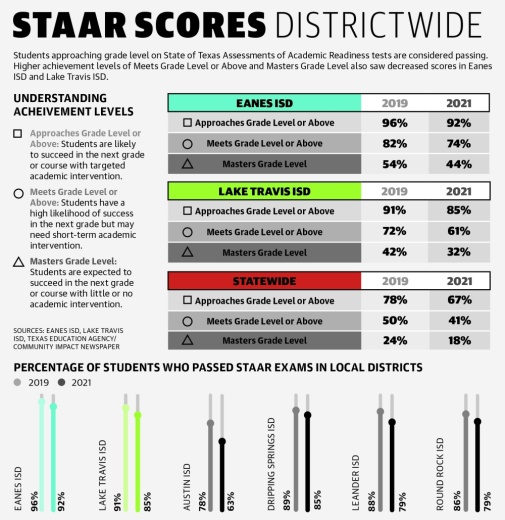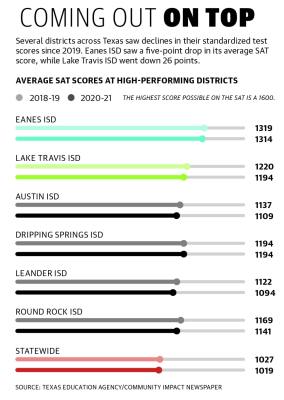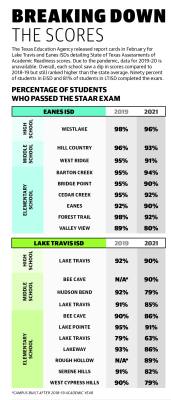These reports show a slight decrease in scores across the board for both Lake Travis ISD and Eanes ISD; however, both schools still remain well above the statewide average in each category.
Schools have made major changes in the past two years to account for the needs of students, including a larger focus on social and emotional learning in students alongside continued efforts to address academic needs through accelerated instruction at LTISD and EISD.
“We have a really strong community that’s very focused on student education,” EISD Chief Learning Officer Susan Fambrough said. “Because of that, our families really support the work that’s being done in schools, so there’s a real partnership with the school and the home.”
Parents pushing their children to complete schoolwork assisted with the transition process between virtual and in-person learning and allowed the districts to continue showing high performance, said Stefanie Allen, LTISD assistant superintendent for curriculum and instruction. Performance varied by campus, however, with some campuses seeing more substantial drops in passing percentages on the STAAR test than others.
Lower average scores
STAAR tests are standardized tests administered by the Texas Education Agency to track student progress and identify students who need more assistance. STAAR tests were not administered in 2020 due to the pandemic, and though the test is usually mandatory, in 2021 students could opt out of the in-person exam. Comparing 2019 scores with 2021 is difficult because the number of students who took the test differs, and results may be skewed as a result, Allen said.••In EISD, the districtwide passing average for STAAR scores went from 96% in 2019 to 92% in 2021. Each campus in EISD generally saw a 2-6 percentage point decrease in its score and remained at or above 90% passing, with the exception of Valley View Elementary, which saw a 9 percentage point decrease from 89% to 80%. Seven of the schools had over 90% of students participate in the tests, while two had over 80%.
“I think that we’re very proud of the scores that we have,” Fambrough said. “Our teachers and our students really worked hard to make sure that learning was still happening and students were engaged.”
The districtwide passing rate for LTISD went from 91% to 85% over the same timeframe and had larger variances in decreasing passing rates between campuses. Lake Travis High School saw the smallest decrease, going from 92% to 90%. The largest decrease in LTISD was for Hudson Bend Middle School, which dropped 13 percentage points from 2019 to 2021, going from 92% to 79%.
Although the decrease is larger, the test participation rate also dropped 33 percentage points compared to the previous year at Hudson Bend Middle School, resulting in the lowest participation rate in the district at 66%. Lake Pointe, Serene Hills and Rough Hollow elementary schools had participation rates of at least 90%, while other schools ranged from 75%-85%.
STAAR exams are graded in four categories: Did Not Meet, Approaches Grade Level or Above, Meets Grade Level or Above and Masters Grade Level. For students, Approaches Grade Level is considered passing but means students may need targeted academic intervention to succeed in the next grade. Meets Grade Level indicates students who have a high likelihood of success in the next grade with short-term academic intervention, while students who receive the Masters Grade Level designation are expected to succeed in the next grade with little or no academic intervention.
Among scores, there were also larger drops in the second and third tier achievement rates for STAAR exams, which could also have been due to students not taking the test, Allen said.
“Especially in our secondary campuses we had quite a large percentage of kids that were learning virtually and then opted not to come in and test,” Allen said. “That’s where we’re going to see that impact from year to year. We are really focusing on student growth ... but that is really hard [to see] on a report card.”
LTISD additionally administered a test for all students to take at the beginning of their academic year in August to gauge student performance and account for students who did not take the STAAR exam in May. These results were used to identify students in need of additional instruction.
Focus on students
Following the onset of the pandemic, districts are now focusing efforts to bolster social and emotional learning, which helps students develop the skills to manage their emotions and establish their identities in the classroom. At both LTISD and EISD, curriculums have been developed for teachers to pull from and incorporate social and emotional learning into their lessons. EISD also has counselors give guidance lessons in classrooms, Fambrough said.
“Our teachers have a firm belief that a relationship is at the core of everything we do,” Westlake High School Principal Steve Ramsey said. “So if you have a relationship with your kids, then that learning is already happening. Our teachers believe they are going to try to take care of students where they’re at and [learn] how to get them to the next stage.”••Kendall Sealy is a seventh grade Texas history teacher at Hudson Bend Middle School. For middle schools in LTISD, a weekly lesson in social and emotional learning is given to students on several topics such as handling stress and anxiety, dealing with peer pressure and setting smart goals.
While virtual instruction taught students the value of communicating their needs with teachers, Sealy said teaching students in person has “made all the difference” in allowing her to read facial expressions and gauge the mental state of students.
“[The student-teacher relationship] is everything in a classroom, and it impacts how they learn, what they learn and if they want to learn,” Sealy said. “I think there has been a rewriting of expectations in terms of what is the most important thing right now. Ultimately, if their social and emotional needs aren’t met, then academics are almost impossible.”••As part of the American Rescue Plan Act of 2021, Elementary and Secondary School Emergency Relief III funds are being provided to districts to respond to the COVID-19 pandemic, safely reopen schools and address the impacts on students. LTISD used a significant portion of the ESSER III funds to create new positions for counselors and social workers in the district to adequately support students.
Addressing academic needs
LTISD and EISD have also had to deal with staffing shortages since the pandemic began. Between teacher and student absences, students have been in a situation that is not ideal for achieving the best educational outcomes, Allen said.
“Students learn best when they have a consistent teacher in the classroom who knows what their deficits are and knows what their strengths are and can really create lessons for students,” Allen said. “Any time we have an interruption, that disrupts the learning cycle.”
When students perform poorly on standardized tests, they now receive accelerated instruction to assist them in their learning. Accelerated instruction focuses on teaching students content alongside their peers at their current grade level while spiraling in concepts from previous grades when necessary, compared to remedial instruction, which focused on students “catching up” with their peers, Allen said.
In 2020-21, EISD teachers introduced “personal work time” into the school calendar, which provided one day a week when students were not learning new material so teachers could support students who needed extra help. LTISD currently has a similar practice in place for students who were identified as needing accelerated instruction. These students now have time built into their schedules to address areas of need determined either by STAAR or the test given to all students at the beginning of the year.
With the introduction of House Bill 4545 in June 2021, some students now come before, during or after school to receive tutoring and targeted intervention based on their needs. At the elementary level, EISD has “Whatever I Need” time for students to get support on specific skills that have been identified by teachers as needing improvement.
EISD school board members received a presentation on the 2021 Texas Academic Performance Report at its March 8 meeting. The report breaks down STAAR data alongside metrics such as graduation rates and college readiness indicators to track student progress. In the report, data is broken down by grade level instead of by school. Since STAAR 2021 data is still being utilized, these performance drops are also reflected in the TAPR report, with some grades seeing 10-15 percentage point drops in master levels.
"I agree ... that our teachers and our administrators have done a yeoman’s job of through the pandemic, and I am exceptionally proud of that,” board member Ellen Balthazar said. “But I am concerned we may have curriculum gaps. I’m curious as to how we can evaluate where we are with our levels of mastery, and as we develop district and campus improvement plans, how we can regain some of that ground we’ve lost.”








